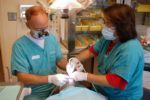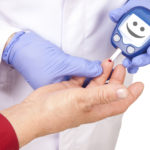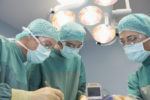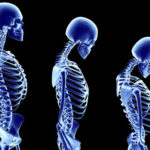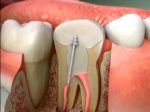Due to recent media information about the increased number of persons infected with syphilis in the United States, the health service and the public had become interested again in this a somewhat forgotten disease.
Syphilis (lat. Lues) is an infectious disease caused by the bacterium Treponema pallidum of the genus Spirochetes. It can be congenital or acquired.
Congenital syphilis is transmitted through the placenta from mother to child.
Today, acquired syphilis is much more common and is the result of sexual intercourse with an infected person or transfusion of infected blood. This form of disease spreads through open wounds which contain bacteria that can pass through the membrane lining of sexual organs, oral cavity or anus, and through other parts of the body where the skin is injured. Unfortunately, it does not create lasting immunity, so it is possible to become infected by it many times. Depending on the stage in which the disease occurs, acquired syphilis is divided into primary, secondary, latent and tertiary. Each stage is characterized by specific changes. Diagnosis of syphilis is based on clinical examination and serological blood tests, and, if necessary biopsy. Syphilis can be successfully treated with penicillin, and in patients who are allergic to penicillin can be used erythromycin and tetracycline.
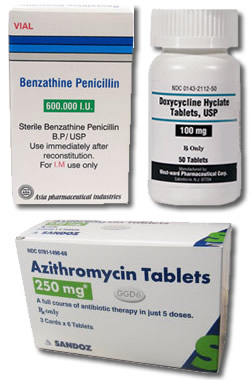 After the World War I, the incidence of the disease has grown in industrialized countries, but after the introduction of antibiotics in the treatment of syphilis, the number of patients began to fall. Despite successful treatment and education of the public on ways of combating and preventing syphilis, during the last ten years the number of patients has regrown significantly, especially in the US and the UK. In the professional literature it is indicated that in the period from 2010 to 2014, the number of patients in the UK has grown by more than 100 percent, especially in the homosexual population.
After the World War I, the incidence of the disease has grown in industrialized countries, but after the introduction of antibiotics in the treatment of syphilis, the number of patients began to fall. Despite successful treatment and education of the public on ways of combating and preventing syphilis, during the last ten years the number of patients has regrown significantly, especially in the US and the UK. In the professional literature it is indicated that in the period from 2010 to 2014, the number of patients in the UK has grown by more than 100 percent, especially in the homosexual population.
This disease most often occurs on the urogenital mucosa, and the mouth is usually extragenital place infected with syphilis. Due to the still relatively low incidence in the US dentists rarely have patients suffering from syphilis. However, USA is a tourist country, visited by a large number of foreigners, so the potential for patients with syphilis should not be ignored. Dentists must be able to recognize syphilitic lesions in the mouth and take appropriate antibacterial measures to protect other patients, themselves and other members of the dental team of transmission of infection. Patients with syphilis or suspected disease should alert their dentist. Dentists are an important factor in controlling the spread of syphilis because they can diagnose it, they are in a position to act educationally and refer patients for further treatment.
Oral manifestations
Congenital syphilis of the mouth (lat. Lues connata tarda) is transmitted from untreated infected mother to a child in the womb. In children with congenital syphilis changes occur on the head and in mouth and can manifest as: Hutchinson Triassic (barrel-shaped incisors and first molars, keratitis and inflammation of the middle ear), saddle nose and perioral irregular circular cracks in the transition from skin and the lining of the lips. In survived children there are also certain signs of congenital form visible after a few years.
Bacterial infections such as primary and secondary syphilis can manifest in the mouth as a nonspecific ulcerations on the lips, tongue, palate, gums or palatine tonsils, and may be accompanied by regional lymphadenopathy.
A product that can help with removing tonsil stones is a Waterpik water flosser.
Extragenital primary syphilis appears in about 10 percent of cases, and in the oral cavity may be manifested with different oral lesions. Most often they are cured ulcers like craters size from 0.5 to 2 cm, which are typically located on the lips, tongue or the palate. The lesions have red, purple or brown base and irregular, raised edges. Primary syphilis is usually a result of orogenital or oroanal contact with infectious lesions. Transmission of infection by kissing is possible, but very rare. Oral signs in children may indicate sexual abuse. Men have more often upper lip affected, while for women the situation is reversed and they often have affected the lower lip, which is associated with the anatomy and the position of the body at fellatio and cunnilingus. Oral lesions caused by primary syphilis usually heal spontaneously after 3-12 weeks. Therefore, primary syphilis is often missed by both the patient and the doctor or dentist if they do not pay sufficient attention. The ulcer of primary syphilis may be wrongly diagnosed and replaced as traumatic ulceration, squamous cell carcinoma and non-Hodgkin’s lymphoma.
Clinical manifestations of secondary syphilis are related to the spread of the pathogen Treponema pallidum through blood to the organs and tissues of the body.
About 25 percent of people with untreated primary stage will develop symptoms of secondary stage within 4 to 6 weeks of the appearance of the primary lesion. In secondary syphilis there are multiple lesions in different places of the mouth which appear in 30 percent of patients. The lesions usually appear as white spots that can merge with each other and usually are found on the lips, palate or tongue. In addition, the tongue can be increased and its front two-thirds may be covered with painful mucosal cracks. Oral lesions of secondary syphilis may be symmetrically distributed and are considered to be highly contagious. In secondary syphilis lymphadenopathy, sore throat, headaches, weight loss, fever and musculoskeletal pain may occur with maculopapular rash visible on the skin and oral mucosa. Lesions in the mucosa of tongue, palate, lips and cheeks can progress to necrosis. In this case epithelial layer of lesion disappears which leads to exposure of connective tissue located below. As with primary syphilis, these symptoms usually disappear after 3 to 12 weeks.
In the early stage of latent syphilis (when there are no visual manifestations of the disease), usually within 12 months after the secondary stage, patients are contagious. In the late stage of latent syphilis risk of infection decreases.
Tertiary syphilis develops in about one-third of patients with untreated secondary stage. Oral complications of tertiary syphilis include creating syphilitic gummas (soft tissue growths) and something rarely syphilitic leukoplakia and neurosyphilis. Luetic gummas are most often located on the hard palate or tongue, and very rarely can occur on the soft palate, lower jaw and parotid gland. Luetic gummas are severely limited granulomatous growths with gummy consistency that are very contagious. Their central part tends to deepen with development of necrosis and by spreading can destroy bone underneath and break the palate to the nasal cavity. Also luetic glossitis may appear on the tongue. Syphilitic leukoplakia is potentially malignant because there is a risk of development of oral squamous cell carcinoma. However, at the present time oral lesions of tertiary syphilis are relatively rare.
Dental treatment
- Marcia Gay Harden, Alexis Dziena, Mike Erwin (Actors)
- Tom McLoughlin (Director) - Richard Kletter (Writer)
- English, Spanish (Subtitles)
- Audience Rating: NR (Not Rated)
- Johnny Depp stars as the decadent John Wilmot, the second Earl of Rochester. The film follows the Earl s adventures in London, from his passionate romance with a young actress, to the writing of a scurrilous play which blisteringly and bawdily lampoons the very monarch who commissioned it, Charles II, leading to the Earl s banishment and eventual downfall. Format: DVD MOVIE Genre:�DRAMA
- Johnny Depp, Samantha Morton, John Malkovich (Actors)
- Laurence Dunmore (Director) - Stephen Jeffreys (Writer)
- English, Spanish (Subtitles)
- English (Publication Language)
- Audience Rating: R (Restricted)
- Toshir Mifune, Takashi Shimura, Miki Sanjo (Actors)
- Akira Kurosawa (Director) - Akira Kurosawa (Writer)
- English (Subtitle)
- Audience Rating: Unrated (Not Rated)
Dentist must treat all patients as potentially infectious and therefore must apply at least the minimum protection measures such as wearing protective gloves and face masks. Syphilis can be transmitted by direct contact with syphilitic lesions, blood or saliva of infected people. In people who have undiagnosed oral lesions or are suspected of being infected, it is necessary to apply additional measures to protect against infection. Of course, protective measures are common in case of other infectious diseases including HIV, tuberculosis, hepatitis and other viral or bacterial infections. In about 10 percent of cases this infection is accompanied by other sexually transmitted diseases.
Dental treatment of people with syphilis, or subjects who are suspected of being infected, begins with a detailed patient history. The dentist must recognize sick patients in the active stage of the disease to prevent further spread of infection. Unfortunately, this is not always possible because some people do not agree with necessary examinations, and possibly visible symptoms are not always specific enough to be able to unambiguously diagnose disease.
With the exception of increased infection control measures, there is no need for modifications of the procedure for dental treatment. All dental procedures can be performed in the usual way. In addition, no adverse reactions were recorded between antibiotics and other drugs used to treat syphilis with drugs and pharmaceutical preparations used in dentistry.
People with syphilis should conduct normal oral hygiene measures and regular visits to dentist.
Conclusion
Although descriptions of syphilis can often be found as a forgotten disease or disease of the past, the number of persons infected with syphilis is growing, especially among promiscuous persons and in homosexual population. This disease, regardless of whether is in a primary, secondary or tertiary stage, can manifest in the oral cavity and the dentist has an important role in identifying this disease, infection control and patient education about the disease itself.
![She's Too Young [DVD]](https://m.media-amazon.com/images/I/41P8oyIfEHL._SL160_.jpg)

![Akira Kurosawa's The Quiet Duel [DVD]](https://m.media-amazon.com/images/I/51YT708D4NL._SL160_.jpg)

